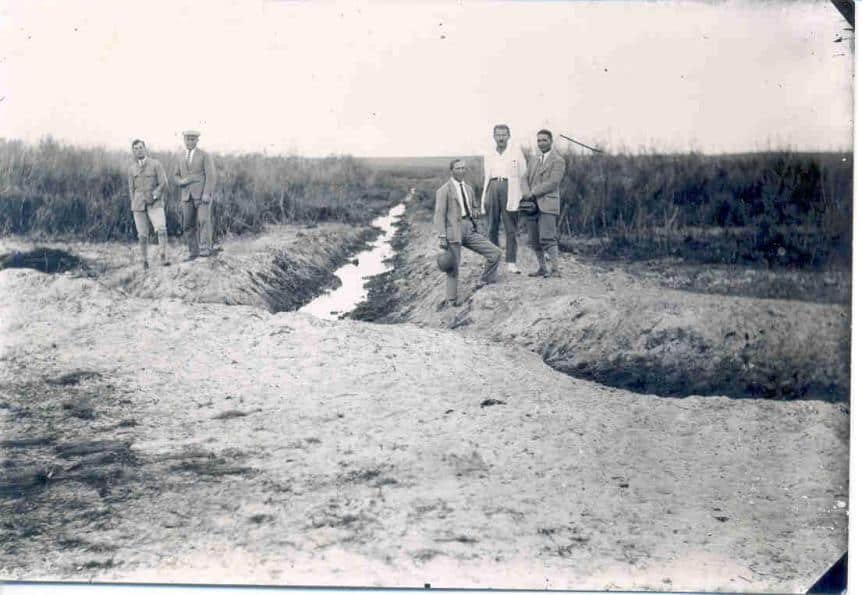A swamp is dammed near the Jewish settlement of Haderah during the First Aliyah.
“Thus says the Lord God: This is Jerusalem. I have set her in the center of the nations, with countries round-about her.” - Ezekiel 5:5
This is part two of the FAI Publishing series Center of Nations which examines the history of the modern State of Israel in the midst of an increasingly hostile world.
A New Paradise in the North
Before rabbis Alkalai, Bibas, and Kalischer had begun challenging European Jewry with their proto-Zionist teachings, subtle but important changes had begun to take place in the Promised Land which would lay groundwork for attracting Jewish immigrants, especially in the northern territory of the Galilee. As the eighteenth century dawned, Eretz Yisrael was a poor and undeveloped backwater of the Turkish Ottoman Empire. Most of its five thousand Jewish inhabitants lived in Jerusalem, Hebron, Jaffa on the Mediterranean, and around the Sea of Galilee. Besides some Muslim and Christian businessmen in the cities, the Land’s 150,000 Arab inhabitants were largely agricultural serfs, farming with primitive tools in meager conditions for wealthy Arab landowners who lived elsewhere.
A modern painting of Daher el-Omar, the Arab-Bedouin ruler of the Galilee district of the Ottoman Empire during the mid-18th century.
Then in the 1720’s, an Arab tax collector for the Ottoman authorities named Daher Omar al-Zaydani took control of the town of Tiberias on the Sea before expanding his territory out across the Galilee to the port of Acre on the Mediterranean. After gaining legitimacy with Ottoman authorities by continuing to collect their taxes, he embarked on a massive building campaign across the fertile plains of the Galilee, while improving the local economy through his control of the agricultural sector. Then in 1757, Omar began rebuilding the small village of Haifa along the Mediterranean coast to become a deepwater port which could accommodate much larger ships than the port at Acre. Funds from increased trade were used to lower taxes and to subsidize more building projects, including new Jewish synagogues and schools. By the 1760’s, the territory of the Galilee had become much more attractive and accessible to Jews who were interested in immigrating to their ancestral homeland, during a time when the Hassidic movement in modern Poland and Lithuania was growing in size and fervency. Thousands of Hassidic, ultra-orthodox Jews moved to the Galilee region, Hebron and Jerusalem in the century that followed, many of them in their old age, as it was considered a blessing to die in the Promised Land. Later called the Old Yishuv, they established Jewish libraries and administered yeshivot, or places of Jewish study, which depended largely on the charity of wealthier Jews in the Diaspora. By 1880, the Jewish population of Ottoman Palestine had grown almost five-fold to around 25,000. But the first massive wave of Jewish immigration was yet to come.
A New Storm in the South
On March 13, 1881, the Tsar of Russia, Alexander II, was assassinated by Russian revolutionaries while returning to his palace in St. Petersburg. Although the wider circle of conspirators included only one Jew (a pregnant woman who owned a safe house used by the revolutionaries), and although there was no evidence of involvement by the wider Jewish community, a rumor spread throughout the Russian Empire that the assassination was a Jewish plot against the crown. As was most often the case in a pogrom, such rumors became convenient pretexts for attacking and marginalizing successful Jewish communities in the Pale of Settlement.[1] Terrible riots broke out in over 200 cities across the Pale. From Warsaw in Poland to Odessa and Kiev in Ukraine, mobs descended on Jewish neighborhoods, looting and burning Jewish homes, businesses, schools, and synagogues. At least 46 Jewish civilians were killed, and over 250 Jewish women were reportedly raped. In most cases, the Russian authorities did not intervene, and some officials were even complicit in the violence. A shadowy organization called the “Sacred League” (which was later revealed to include high-ranking Russian government officers) had previously sent letters to local officials before the violence began, encouraging them to refrain from interfering with the mobs after they took to the streets, and allowing the worst pogroms against European Jews in almost 500 years. They became collectively known as HaSufot BaNegev, or “The Storms in the South,” as most of the devastation was concentrated in the southern half of the Pale of Settlement.
Pogrom in Kiev, Russian empire, 1881. Jews being molested while police look on. Published in "The Penny Illustrated Paper", Feb. 4 1882, No. 1074 - Vol. 42. Unknown author.
Adding insult to injury, the new Russian Czar Alexander III passed a series of laws in May, 1881 that further restricted Jewish residency and restricted land ownership in the Pale of Settlement. Most Jews were restricted from practicing medicine and law, while all Jews were banned from running in local elections. This meant that Russians would control the Empire’s only Jewish-majority communities. Together with the fresh wounds of mob violence, the so-called May Laws convinced many Jewish families that there was no viable future for them in the Russian Empire. Hundreds of thousands of Jews emigrated to the United States before the turn of the twentieth century. But some looked instead to their ancestral homeland. Inspired by a mix of ancient Biblical connection to the Land and modern Marxist ideals of collectivism, two Jewish organizations were formed named Hovevei Zion, or Lovers of Zion,” and BILU, an acronymous name taken from the Hebrew of Isaiah 2:5: Beit Ya'akov Lekhu Ve-nelkha, translated in English as “Let the House of Jacob go.”
The First in zion
The first expedition of 14 Bilu’im, as they were called, arrived in the Land in July, 1882. Thousands more followed. Some learned a trade and settled in the established cities of Jerusalem and Jaffa. Others attended the agricultural academy at Mikve Yisrael near the central coast land and founded a moshava, or rural farming community. Rishon L’Zion, or “First in Zion,” was the first settlement established by Jewish migrants in the Promised Land, growing to over 100 inhabitants in its first year.
By 1883, however, the so-called New Yishuv of Hovevei Zion and BILU were in dire straits. The cost of cultivating their arid and barren farmland was greater than they had anticipated. They were in particular need of water, which had to be carried on camel-back from other settlements. Compounding the threat of starvation was that of Arab marauders, who regularly raided frontier settlements such as G’dera, dispossessing the Jewish residents there. Thousands returned to Europe, and the movement was on the verge of collapse. In a desperate effort, Rishon L’Zion sent a representative to Europe, seeking patronage from Jewish financiers. They found an especially exuberant and steadfast ally in Baron Edmond De Rothschild, head of the Paris branch of the incredibly wealthy Jewish banking family. Rothschild was already an active philanthropist, and the vision of the migrants sparked his imagination. He financed the drilling of a deep well in Rishon L’Zion as the first of thousands of initiatives in the Land to support the New Yishuv, including farms, Hebrew-language schools, almond orchards, vineyards, wineries, synagogues and medical clinics. The Baron even financed the draining of swamps to eradicate malaria. These projects paved the way for a second wave of Jewish migration in 1890, almost 10 years after the first Bilu’im arrived. Additional moshavot sprung up across the Land, some of which were named after members of the Rothschild family. Rishon town and continued to grow in the following decades into a thriving town, and is today the fourth largest city in Israel. Twenty years after his death, in 1954, the Baron Edmond De Rothschild was disinterred and reburied in the nascent Jewish State near an old moshava settlement that bore his name. David Ben-Gurion, the first prime minister of modern Israel, eulogized Rothschild, saying, “I doubt that in the entire history of the Jewish people in the Diaspora, a period of 2,000 years, one could ever find a man comparable in stature to the incredible figure that was the Baron Edmond de Rothschild – the builder of the Jewish Yishuv in our renewed homeland.”
An early photograph of the nascent Jewish community of Rishon L’Zion.
The first waves of olim, or immigrants, in the 1880’s and 90’s would eventually become known as the First Aliyah. The act of aliyah, as ancient as the Hebrew Scriptures, was the act of “going up” to Jerusalem to worship God during the festivals. It was not only a physical ascent through the rugged Judean hills, but also a spiritual one, as the travelers sang the ancient liturgy of the psalmists to prepare their hearts for worship. At the end of the nineteenth century, the aliyah had come to represent a “going up” that differed from those who came before. Instead of cloistering in study or awaiting a blessed death, the New Yishuv built a movement around growing and vibrant communities, diverse in vocation and skill, and connected to the entire Land. By the turn of the twentieth century, almost 35,000 had arrived in Eretz Yisrael from Eastern Europe and Yemen, more than doubling its Jewish population (although roughly 15,000 would later emigrate to other places). Having acquired over 35,000 hectares (86,000 acres) of land, they formed almost 30 settlements, and began to build, plant and multiply. It was only the beginning.
Gabe Caligiuri is the editor of THE WIRE, as well as an occasional contributor to other FAI digital content on the subjects of history and geopolitics as they relate to the Great Commission. Gabe and his family live in California.
Endnotes:
[1] The Pale of Settlement was a western region of the Russian Empire in modern-day Eastern Europe that existed from 1791 to 1917 in which the vast majority of the empire’s Jewish population was forced to live.






